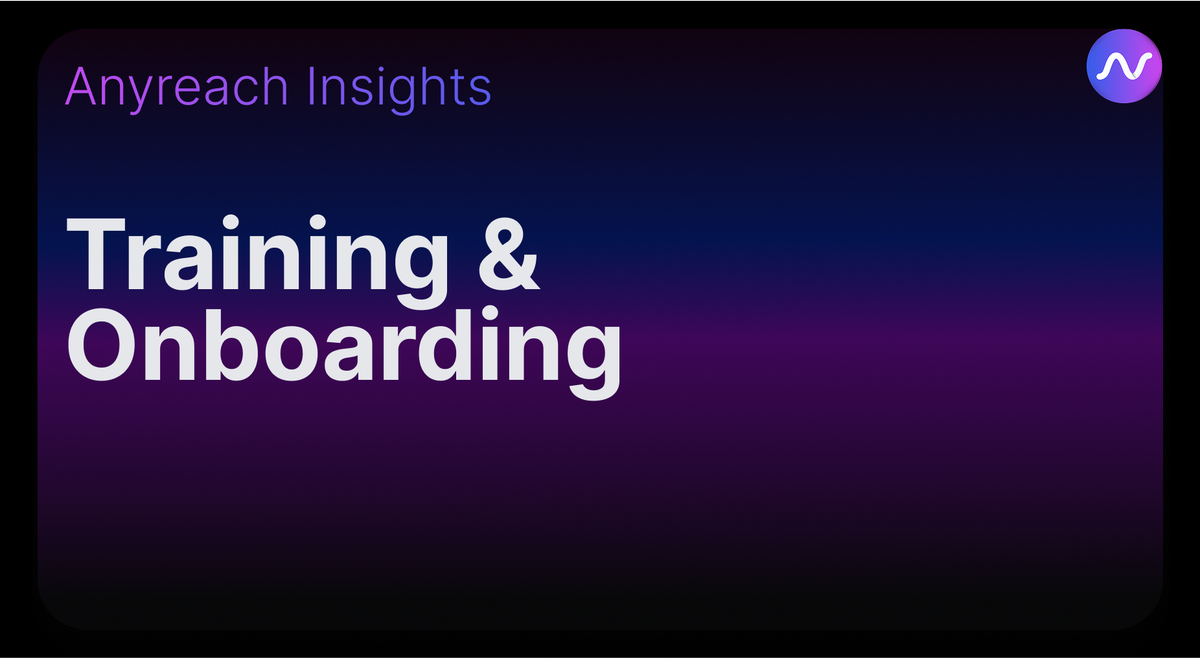Enterprise Agentic AI Training & Onboarding: A Complete Implementation Guide for BPOs and Service Companies

Enterprise Agentic AI Training & Onboarding: A Complete Implementation Guide for BPOs and Service Companies
As enterprises race to adopt agentic AI, the path from concept to deployment remains shrouded in uncertainty. With 72% of companies now investing in AI but only 47% making sufficient progress, the gap between ambition and execution has never been clearer1. For BPOs and service-oriented companies, understanding the training and onboarding process is critical to avoiding the pitfalls that derail nearly half of all AI initiatives.
What is agentic AI onboarding?
Agentic AI onboarding is the structured process of implementing autonomous AI agents within enterprise operations, encompassing discovery, pilot programs, training, and phased deployment to ensure seamless workflow integration.
Unlike traditional software implementation, agentic AI onboarding requires a fundamentally different approach. These systems don't just execute predefined tasks—they perceive, reason, plan, and learn autonomously. The onboarding process must therefore address not only technical integration but also organizational readiness, compliance frameworks, and continuous learning mechanisms.
According to recent enterprise surveys, organizations with formal AI strategies report 80% implementation success rates, compared to just 37% for those without structured approaches2. This stark difference underscores why systematic onboarding isn't optional—it's the foundation of successful AI adoption.
Core Components of Enterprise Agentic AI Onboarding
- Domain-specific deployment: Developing agents tailored for specific tasks (customer service, IT support, RFP drafting)
- Universal agent architecture: Implementing a single entry point with reasoning engines to route queries appropriately
- Continuous learning infrastructure: Building feedback loops that leverage call recordings and interaction data
- Compliance and governance frameworks: Establishing guardrails for data privacy, decision boundaries, and audit trails
How do discovery calls shape AI training for BPOs?
Discovery calls establish the foundation for AI training by mapping workflows, identifying automation opportunities, and determining specific training requirements including language support and compliance needs.
For BPOs handling complex, multi-channel customer interactions, discovery calls serve as the critical first step in designing effective AI agents. These structured sessions go beyond simple requirements gathering—they create a blueprint for how AI will transform operations.
Discovery Call Framework Components
| Component | Focus Area | Key Outputs |
|---|---|---|
| Process Mapping | Current workflows and pain points | Automation opportunity matrix |
| Data Assessment | Call recordings, knowledge bases | Training data requirements |
| Integration Scoping | CRM, telephony, legacy systems | Technical architecture plan |
| Compliance Review | Regulatory requirements, data privacy | Governance framework |
| Success Metrics | KPIs, ROI targets | Measurement dashboard |
The most effective discovery processes incorporate role-playing scenarios that simulate critical agent interactions. By walking through actual customer conversations, enterprises can identify edge cases and refine requirements before deployment begins. This approach is particularly valuable for BPOs serving global markets, where multilingual support and cultural nuances add layers of complexity.
Building Knowledge Bases from Call Recordings
Call recordings transform into structured knowledge bases through transcription, semantic indexing, and iterative refinement, creating the foundation for contextually aware AI agents.
The process of converting raw call data into actionable AI training material requires sophisticated middleware and careful orchestration. Modern frameworks like LlamaIndex enable semantic search capabilities that go far beyond keyword matching, allowing agents to understand context and intent.
Knowledge Base Development Process
- Transcription and structuring: Converting audio to text with speaker identification and timestamp preservation
- Semantic indexing: Organizing content for context-aware retrieval using vector embeddings
- Quality assurance: Ensuring accuracy, completeness, and compliance with privacy regulations
- Continuous enrichment: Adding new interactions and refining categorization based on agent performance
For service companies handling sensitive customer data, this process must balance comprehensive training with strict privacy requirements. Anonymization techniques and robust data governance frameworks are essential, particularly when dealing with healthcare, financial, or other regulated industries.
Role-Playing: The Secret to Multilingual AI Success
Role-playing scenarios enhance AI training by simulating complex customer interactions across languages and cultures, significantly improving agent performance in real-world deployments.
While call recordings provide historical data, role-playing scenarios allow enterprises to proactively train agents for situations they haven't yet encountered. This is particularly crucial for multilingual support, where direct translation often fails to capture cultural context and communication styles.
Research shows that BPOs using comprehensive role-playing training see 40% faster time-to-competency for AI agents handling multilingual interactions3. The investment in scenario development pays dividends through reduced escalation rates and improved customer satisfaction scores.
Effective Role-Playing Implementation
- Scenario libraries: Building comprehensive collections covering common and edge cases
- Cultural adaptation: Training agents to recognize and respond to cultural communication patterns
- Escalation protocols: Defining clear handoff procedures for complex situations
- Iterative refinement: Using performance data to continuously improve scenarios
What timeline should a service company expect for a POC using call recordings for AI training?
Service companies typically see POC results within 6-12 weeks using proven platforms, while custom implementations may require 6-12 months to achieve comparable outcomes.
The timeline for implementing agentic AI varies significantly based on approach, complexity, and organizational readiness. Understanding these variations helps enterprises set realistic expectations and allocate resources appropriately.
Implementation Timeline Comparison
| Phase | Platform-Based Approach | Custom Development | Key Activities |
|---|---|---|---|
| Discovery & Planning | 1-2 weeks | 4-6 weeks | Requirements gathering, architecture design |
| Data Preparation | 2-3 weeks | 8-12 weeks | Call recording processing, knowledge base creation |
| Initial Training | 2-3 weeks | 12-16 weeks | Model training, role-playing scenarios |
| Testing & Refinement | 1-2 weeks | 4-8 weeks | Performance validation, iterative improvement |
| Pilot Deployment | 1-2 weeks | 4-6 weeks | Limited production rollout, monitoring |
These timelines assume adequate data quality and organizational commitment. Enterprises often underestimate the importance of change management—48% of employees cite training as crucial to adoption success, yet many organizations allocate insufficient resources to this critical component4.
Overcoming Common Implementation Challenges
The path to successful agentic AI deployment is fraught with technical and organizational obstacles. Understanding these challenges—and their solutions—can mean the difference between joining the 47% of enterprises making real progress or becoming another cautionary tale.
Technical Challenges and Solutions
- Legacy system integration: Use middleware and API layers to bridge modern AI with existing infrastructure
- Data quality issues: Implement robust data cleaning and validation processes before training begins
- Scalability concerns: Start with modular, domain-specific agents that can expand incrementally
- Security and compliance: Build governance frameworks from day one, not as an afterthought
Organizational Challenges and Solutions
- Resistance to change: Involve stakeholders early through workshops and demonstration sessions
- Skill gaps: Invest in comprehensive training programs for both technical and business users
- Siloed development: Create cross-functional teams to ensure enterprise-wide alignment
- Unrealistic expectations: Set clear, measurable goals and communicate progress transparently
The Future of Enterprise AI Training
As agentic AI matures, the training and onboarding landscape continues to evolve. Enterprises that invest in robust implementation frameworks today position themselves to leverage tomorrow's advances. The key lies not in waiting for perfect technology but in building the organizational capabilities and processes that enable continuous improvement.
With 92% of companies planning to increase AI investment over the next three years5, the question isn't whether to adopt agentic AI, but how to do it successfully. By focusing on structured onboarding, comprehensive training, and realistic timelines, enterprises can navigate the complexity and unlock the transformative potential of autonomous AI agents.
Frequently Asked Questions
How long does it take to train an AI agent using call recordings?
Initial training typically takes 2-3 weeks with platform-based solutions or 12-16 weeks for custom development. However, continuous learning means training is an ongoing process that improves agent performance over time.
What volume of call recordings is needed for effective AI training?
While requirements vary by use case, most enterprises need at least 1,000 hours of transcribed, categorized call recordings to establish a baseline. Quality matters more than quantity—well-annotated data from 500 hours often outperforms poorly structured data from 5,000 hours.
How do we ensure compliance when using call recordings for AI training?
Implement anonymization techniques, obtain proper consent, and establish data retention policies aligned with regulations like GDPR or CCPA. Work with legal teams to create governance frameworks that balance training effectiveness with privacy protection.
Can AI agents handle multiple languages from the start?
While technically possible, best practice suggests starting with a single language for POCs, then expanding based on performance metrics. Each language requires specific training data and cultural adaptation, making phased rollouts more manageable and successful.
What's the typical ROI timeline for agentic AI in BPOs?
Early adopters report initial ROI within 6-12 months for well-defined use cases, with full value realization typically occurring at the 18-24 month mark. Organizations with mature AI strategies see 70% achievement of anticipated benefits compared to lower rates for less prepared enterprises.
1 Coherent Solutions. (2025). "AI Adoption Trends You Should Not Miss 2025." Retrieved from coherentsolutions.com
2 Writer. (2025). "Enterprise AI Adoption Survey." Retrieved from writer.com
3 Gnani.ai. (2025). "How Global BPOs Use Agentic AI to Cut Costs and Boost Accuracy." Retrieved from gnani.ai
4 G2 Learn. (2025). "AI Adoption Statistics." Retrieved from learn.g2.com
5 Deloitte. (2025). "Generative AI Survey Finds Adoption Moving Fast." Retrieved from deloitte.com


